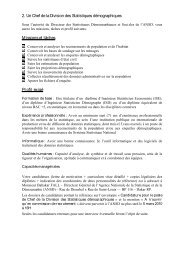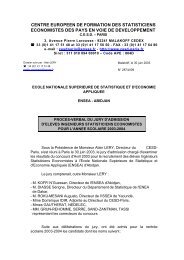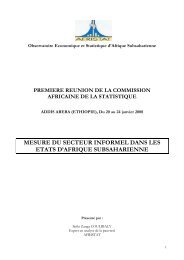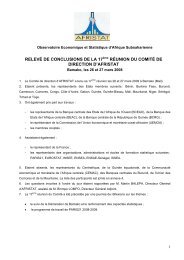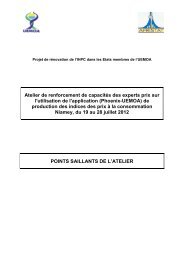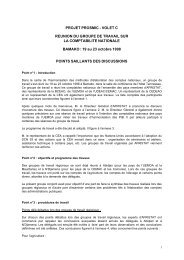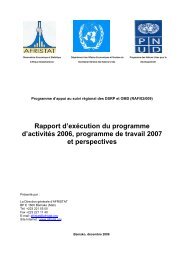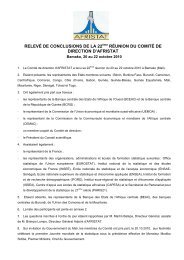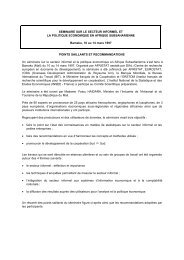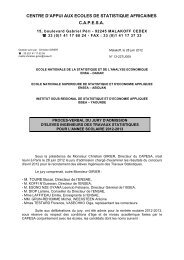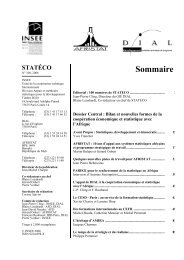Global Purchasing Power Parities and Real Expenditures - Afristat
Global Purchasing Power Parities and Real Expenditures - Afristat
Global Purchasing Power Parities and Real Expenditures - Afristat
You also want an ePaper? Increase the reach of your titles
YUMPU automatically turns print PDFs into web optimized ePapers that Google loves.
152 <strong>Global</strong> <strong>Purchasing</strong> <strong>Power</strong> <strong>Parities</strong> <strong>and</strong> <strong>Real</strong> <strong>Expenditures</strong>stage, a Quaranta validation table could be produced foreach basic heading, allowing the regional coordinator tocompare characteristics of the prices between economies(for example, their relative levels, variation, <strong>and</strong> dispersion)after converting them to a common currency, using bothexchange rates <strong>and</strong> PPPs.Another editing facility used for the first time in the2005 ICP was the Dikhanov table, which extended thetype of analysis provided by the Quaranta table. The maindifference between the two is that the Quaranta table concentrateson key features of the data at the basic-headinglevel while the Dikhanov table presents a broader overviewacross basic headings.The feedback from the preliminary editing phase provideda means, early in the price collection cycle, of identifyingproducts that were being incorrectly identified orpriced. The data validation was an iterative process: as dataproblems were identified <strong>and</strong> corrected, the relationshipspresented in the tables changed, <strong>and</strong> therefore several cycleswere normally required to complete the data cleaning.The process was managed by the regional coordinators,who sent queries to the national coordinators. Once theproblems identified in the price data were resolved, a secondset of Quaranta <strong>and</strong> Dikhanov tables was produced,<strong>and</strong> the detailed checking process was repeated. At aboutthis time, most regions held a data validation workshop. Thepurpose of these workshops was to have price experts fromeach economy in the region review, as a group, the pricedata in a “semifinal” state. The aim was to finalize productprices by resolving data queries during the meeting. Inevitably,it was not possible to resolve every problem, <strong>and</strong> soa major outcome of a data validation workshop was a listof potential problems for which the price statisticians hadto find an explanation for apparent anomalies or providecorrected prices.Once the price data were considered final, nationalcoordinators were asked to formally approve their owneconomy’s prices. Final Quaranta <strong>and</strong> Dikhanov tableswere circulated as part of this process.Data Validation: National AccountsA crucial aspect of data validation was to make internationalcomparisons of the contributions of each basic headingto GDP. Any significant differences that could not bereadily explained by the regional coordinator’s team werereferred back to the national coordinators concerned forresolution. The patterns of expenditure between differentgroupings of economies were also compared. For example,the share of GDP spent on basic needs, such as food, shouldbe relatively high in low-income economies, while theshare of expenditure on luxury items, such as motor vehicles,should be higher in the high-income economies. Suchchecks are fairly subjective, but they identified problemsthat had to be corrected before each region’s comparisonswere finalized.Data Issues <strong>and</strong> AccuracyThe ICP is a very large statistical program, which uses notonly existing data sources (for example, national accountsdata) but also data derived from special surveys, particularlyto obtain prices not otherwise available. The resultsare published on an economy basis, so each economy hasa stake in the accuracy of its results. Consequently, thereis shared responsibility for editing the ICP inputs <strong>and</strong> outputs,although the global office is ultimately responsible forthe quality of the final overall results.Several steps were taken to improve data accuracy startingwith the careful selection <strong>and</strong> defining of products to bepriced via the structured product definitions. The next stepwas data validation at the regional level, where workshopswere convened after each data collection <strong>and</strong> where economiesreviewed the prices submitted to determine whetherall priced the same product the same way.When comparing GDP volumes between economies, itis also necessary to take into account the accuracy of theunderlying national accounts estimates. The estimates ofGDP in national currencies can have large errors associatedwith them. For example, substantial revisions have beenmade to the level of GDP in many economies over the pastdecade as more <strong>and</strong> better statistical surveys have becomeavailable, particularly in the area of services, <strong>and</strong> as thenonobserved economy has been covered more comprehensively.Any such shortcomings in the national accounts dataaffect the international comparisons for those economies,no matter whether PPPs or exchange rates are used.As is the case with national accounts data in general, thedata for some aggregates are more accurate than those forothers. Sometimes the quality of the underlying data source



